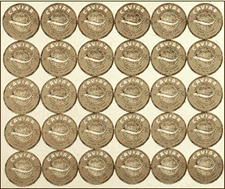Idea Against Materia: On the Consumption of Post-Soviet Art
No matter how much it wanted to escape into the sanctuary of beauty, art had to serve in the war between communism and capitalism. Both in the former Soviet Union and in the West, the rhetoric of art criticism was laced with ideological animosity.
Soviet art criticism formulated the conflict in terms of the difference between life and death, no more and no less. Since the early 1930s, these tropes were used to defend the virtues of realism against the threat of modernism and abstraction: if “their” art was about expression, individualism, and therefore morbid and decaying, “our” art would be realist, collective, and life-asserting.
During the cold war, the persuasiveness of this contrast grew ever more powerful. In a 1964 book-length review of the Venice Biennale, published under the title “Art of Life or Art of Nothingness”, Yuri Pimenov demonstrated the principle vividly both on the title page and in the layout of the illustrations, designed to highlight the contrast between the West’s morbid abstractions and the life-asserting realist images of Soviet art.
The United States, in its turn, enlisted art in the service of the Cold-War. Eva Cockcroft demonstrated very convincingly how in the early 1950s the CIA supported the promotion of Abstract Expressionism as representative of individual freedom of expression in direct opposition to Soviet art, which was seen as collective propaganda, and therefore not art at all, in the modernist definition.
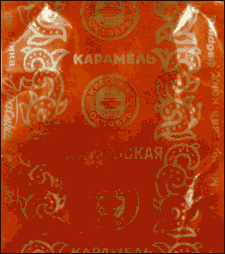 Mandated by the state doctrine of Socialist Realism and regulated by the Union, official Soviet art acted as the invisible Other that defined American discourse on the production and teaching of modernism. Clement Greenberg’s “Avant-Garde and Kitsch” clearly defined Western modernism in opposition to official Soviet art. Similarly, the adaptation of Kandinsky’s writings, such as On the Spiritual in Art, as the founding texts of American art education is significant in that it translated expressionism into an ideology of uninhibited, individual creativity at the expense of collective art production. It is not surprising that the critique of Greenbergian modernism in the 1980s in this country emanated from leftist positions represented by such journals as October. As a reference to Sergei Eisenstein’s film of the same title and, more obliquely, to the October Revolution, the journal’s title stands as an ideational symbol representing ideology understood as a body of texts and ideas. There are other “Octobers,” the kind that make ideology relevant to the real, physical, material body, such as the one imprinted on the wrapper from “October” candy produced by the Red October chocolate factory in Moscow. It is these kinds of signs, signs that appeal to the senses as well as to the mind, that are of interest to me here.
Mandated by the state doctrine of Socialist Realism and regulated by the Union, official Soviet art acted as the invisible Other that defined American discourse on the production and teaching of modernism. Clement Greenberg’s “Avant-Garde and Kitsch” clearly defined Western modernism in opposition to official Soviet art. Similarly, the adaptation of Kandinsky’s writings, such as On the Spiritual in Art, as the founding texts of American art education is significant in that it translated expressionism into an ideology of uninhibited, individual creativity at the expense of collective art production. It is not surprising that the critique of Greenbergian modernism in the 1980s in this country emanated from leftist positions represented by such journals as October. As a reference to Sergei Eisenstein’s film of the same title and, more obliquely, to the October Revolution, the journal’s title stands as an ideational symbol representing ideology understood as a body of texts and ideas. There are other “Octobers,” the kind that make ideology relevant to the real, physical, material body, such as the one imprinted on the wrapper from “October” candy produced by the Red October chocolate factory in Moscow. It is these kinds of signs, signs that appeal to the senses as well as to the mind, that are of interest to me here.
With its ironic insistence on the domestication of ideological signs, post-Soviet art reveals something not only about the symbolization of ideology but also about its consumption on both sides of the divide. Apart from influencing the fundamental discourse on art, anti-communist politics and the Cold War created a binary rhetorical system that allowed to imagine lives on either side of the Berlin Wall. The key tropes of this rhetoric are idea and materia. Ideology is the word of choice when Soviet history is evoked. A well-defined, doctrinaire communist ideology appears to have ruled everything from foreign policy to apartment furnishings, from art to dress, from the content of evening news to the contents of one’s dinner plate. Although the ideology itself was based on Marx’s dialectical materialism, Soviet life was somehow imagined as immaterial, as ignoring matter. Human bodies mattered only as long as they could bear an ideological imprint. It is as if Soviet life were “life as idea,” lived through a system of disembodied symbols.
Materialism, on the other hand, almost exhaustively explains twentieth century lives in the West, in the societies of consumption, where the satisfaction of corporeal needs and desires is turned into a source of industrial revenue. Western bodies strive for material luxury, for comfort and convenience. As opposed to communist ideology, the ideology of consumption has no symbols, even though it is materially manifest. The critique of this ideology can approach it only from its immediate materiality. In this way, Andy Warhol’s Campbell Tomato Soup Cans remains the most poignant image of the frightening nature of the society of consumption. Campbell’s tomato soup, that canned potion of maternal care and nourishment, was revealed to be an anonymous product of industrial production in all its grandiosity and indifference. Tomato soup cans or Coca-Cola bottles are not presented exclusively as ideological symbols but also as material figures capable of triggering affective memory in those who consume their contents.
Thus the worlds of idea and materia became disassociated in the cold war. Idea was denied the kind of expression that is commonly triggered by personal encounters with the material: textures, smells, vision. The Soviet world has been consistently imagined as not only anti-materialist but also as immaterial. And therefore, when after glasnost’ in the late 1980s unofficial Soviet art became accessible to American audiences and the market, its interpretation was immediately restricted to the established rhetorical schemata, although with a twist: on the one hand, it was hailed as the art of individuals struggling against the tyranny of the collective; yet on the other hand, it was denied lyrical expression; it was interpreted as epic art ruled by an idea and interpreted in terms of ideological conflict. Two competing desires converged to create this interpretation of post-Soviet art, at least in Anglo-American culture; on the one hand, the desire of the art market and, on the other hand, the desire of the American left that was mounting its own critique of formalist modernism and was eager to see politically potent art.
Post-Soviet art, I mean by that the kind of art that deals with the Soviet experience more or less explicitly, is an art of memory. For the most part, it is paradoxically nostalgic. Its yearning for the past despite the obvious opposition to the Soviet regime’s political legacy represents a conflict between affective, material memory and traditional symbolic memory. It asserts the experience of individual lives embedded in the history of the life of the state.
Through materia, representing the fabric of everyday life and the material of art, the interpretation of post-Soviet art and the experience of Soviet life can be reclaimed. The following example of an early encounter of post-Soviet art with American viewers illustrates the conflict between ideological interpretation and material memory.
The Stubborn Stains
In 1991 the Ronald Feldman Gallery in New York showed the work by Peppers, a collaboration of the Russian artist-couple Oleg Petrenko and Liudmila Skripkina. Feldman was one of the dealers who took on the work of Soviet unofficial art that became available for export and sale after glasnost’. Peppers represent the “younger generation” who came of age in the mid 1980s; their work, to a great extent, explicitly pays homage to the unofficial artists who defined the range of problems and aesthetic solutions within Russian conceptual art.
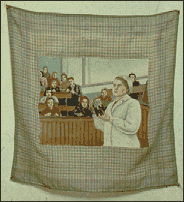 One of the rooms of the gallery was filled by a series of Sixteen Handkerchief Paintings. These were miniature scenes from everyday Soviet life painted on old white square handkerchiefs framed by printed border patterns. The scenes included a tram starting its route on an empty morning street, three women sitting under giant hair dryers in a beauty salon, a lecturer in a white medical uniform in front of a student audience, as well as similar slices from everyday life. The Handkerchief Paintings contained a surprising detail that connected this series with the artists’ installations in other rooms of the gallery; within each scene, if one examined it closely, there was a startling central object wrapped into what looked like a science table torn out of a textbook or a journal. The aesthetic of Soviet “popular-scientific” publications from 1930s-60s is the visual foundation upon which Peppers built their conceptual explorations of the interplay of science and everyday life with its mixture of highly rational discourse with the mundane chatter about potato shortages. This aesthetic is exemplified by a typical butcher’s shop poster that was a mandatory presence in every meat department of grocery stores, even in the absence of the actual meat for sale.
One of the rooms of the gallery was filled by a series of Sixteen Handkerchief Paintings. These were miniature scenes from everyday Soviet life painted on old white square handkerchiefs framed by printed border patterns. The scenes included a tram starting its route on an empty morning street, three women sitting under giant hair dryers in a beauty salon, a lecturer in a white medical uniform in front of a student audience, as well as similar slices from everyday life. The Handkerchief Paintings contained a surprising detail that connected this series with the artists’ installations in other rooms of the gallery; within each scene, if one examined it closely, there was a startling central object wrapped into what looked like a science table torn out of a textbook or a journal. The aesthetic of Soviet “popular-scientific” publications from 1930s-60s is the visual foundation upon which Peppers built their conceptual explorations of the interplay of science and everyday life with its mixture of highly rational discourse with the mundane chatter about potato shortages. This aesthetic is exemplified by a typical butcher’s shop poster that was a mandatory presence in every meat department of grocery stores, even in the absence of the actual meat for sale.
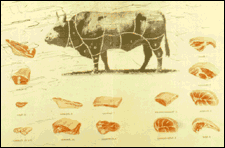 The scenes of Soviet everyday life painted on the handkerchiefs could have been copied from any popular magazine but their unusual cotton “canvases” endowed them with the special air of nostalgia. Unlike the larger installations, paintings, and objects in other rooms, these little pieces of material were particularly touching. The handkerchiefs themselves were almost painfully easy to recognize. They were the receptacles of tears and mucus from the days of childhood, deposits or stains which our mothers and grandmothers struggled for days to bleach out. Here the stains were exhibited for all to see, as traces of “teary” genre scenes, internalized by the body and the mind, and oozed out through the eyes or the nose. As on Veronica’s veil, the stain developed into an image of what is most revered and beloved, except in this case it was the bittersweet image of collective childhood experience. By triggering “bodily” memory through an indexical reference to lived experience, the fabric, the material on which the scenes were painted hadthe rhetorical power to transform the image’s negative and frustrating content into an object of nostalgia.
The scenes of Soviet everyday life painted on the handkerchiefs could have been copied from any popular magazine but their unusual cotton “canvases” endowed them with the special air of nostalgia. Unlike the larger installations, paintings, and objects in other rooms, these little pieces of material were particularly touching. The handkerchiefs themselves were almost painfully easy to recognize. They were the receptacles of tears and mucus from the days of childhood, deposits or stains which our mothers and grandmothers struggled for days to bleach out. Here the stains were exhibited for all to see, as traces of “teary” genre scenes, internalized by the body and the mind, and oozed out through the eyes or the nose. As on Veronica’s veil, the stain developed into an image of what is most revered and beloved, except in this case it was the bittersweet image of collective childhood experience. By triggering “bodily” memory through an indexical reference to lived experience, the fabric, the material on which the scenes were painted hadthe rhetorical power to transform the image’s negative and frustrating content into an object of nostalgia.
While I was pondering the rhetorical complexity of the handkerchief paintings, a group of visitors came through the gallery. The group, consisting of amateur collectors, was lead by an expert art consultant whose responsibility it was evidently to explain the work on exhibit and convince the group of the value of buying the new Russian art. Pausing for a minute in front of the handkerchiefs, the expert stated with a great sense of confidence that the unofficial Russian artists were prosecuted and so poor that they were forced to paint on any material at hand, including the old tattered handkerchiefs. The group nodded with understanding and sympathy.
This was a typical meeting of new Russian art with the American art market; the art of the victims of the hated Soviet regime sells much better than the art of resourceful young artists who explore the complexity of the bittersweet legacy of Soviet life. Here, what is “Soviet” is not easily extricated from the personal; the ideological from the material; the epic from the lyrical.
Consuming the Sign
In the absence of any space for internal critical discourse on art and the orientation of post-Soviet art towards the Western market and funding sources, it is understandable that the interpretative schemes for making sense of this art were provided by the West. What is yet to be shown is that despite the variety of approaches to the Soviet experience and the fact that a lot of it is the work of ideological critique, post-Soviet art put a twist on this critique by insisting on filtering ideology through private experience, by letting political symbols dissolve in the materiality of life. In performing this operation, it revealed the fragility and impotence of symbolic ideology in the face of the power of individuals to domesticate symbols through the subversive labor of the body.
Exploring the conflict between public symbolism and private realities, post-Soviet art reveals the dual nature of the ideological sign, a kind of optical illusion where background and foreground shift, where the material becomes the sign itself and Soviet ideology is experienced through the senses rather than purely discursively.
 One of the best known movements within post-Soviet art is Sots Art which parallels American pop-art. Vitaly Komar and Alexander Melamid introduced Sots Art in the early 1970s with their mocking, ironic reworking of the images of Soviet public life, such as the painting Our Goal Is Communism (signed “Komar and Melamid”). In their footsteps, Alexander Kosolapov made references to Pop-Art in even more direct ways. His painting Caviar is explicitly based on Andy Warhol’s Tomato Soup Cans. Here is an alternative view the Cold War: the symbols of state power are constituted by consumer food products rather than abstract ideological figures. Similarly, Kosolapov’s Coca-Cola painting represents a meditation on the status of brand names in relationship to Soviet political symbolism. By associating somber political symbols with consumer products, and particularly with food, Kosolapov effectively neutralizes them. Ideological discourse becomes edible; what can be enjoyed as food is no longer imposing or threatening.
One of the best known movements within post-Soviet art is Sots Art which parallels American pop-art. Vitaly Komar and Alexander Melamid introduced Sots Art in the early 1970s with their mocking, ironic reworking of the images of Soviet public life, such as the painting Our Goal Is Communism (signed “Komar and Melamid”). In their footsteps, Alexander Kosolapov made references to Pop-Art in even more direct ways. His painting Caviar is explicitly based on Andy Warhol’s Tomato Soup Cans. Here is an alternative view the Cold War: the symbols of state power are constituted by consumer food products rather than abstract ideological figures. Similarly, Kosolapov’s Coca-Cola painting represents a meditation on the status of brand names in relationship to Soviet political symbolism. By associating somber political symbols with consumer products, and particularly with food, Kosolapov effectively neutralizes them. Ideological discourse becomes edible; what can be enjoyed as food is no longer imposing or threatening.
Post-Soviet art pitches the collective memory of life as materia against the symbolic memory of life as idea. However, this experience-based collective memory is not preserved in art alone. The ex-Soviet immigrant community, which could be called post-Soviet long before 1991, manifests this kind of memory in its rituals. This community’s unexpected nostalgia for “Sovietness” is also a nostalgia for the material aspects of life triumphing over ideology.
There is no better example of this nostalgia than the memory of food. The persistence of taste is the most striking manifestation of physiological memory, whereby the body asserts its claim to remember, where collective memory is directly imprinted on corporeal desires. It is not surprising, then, that Proust’s “petite madeleine” memory, with its flood of triggered associations, is one of the foci of memoriological scholarship that attempts to elucidate the dwelling sites of collective memory.
The largest ex-Soviet immigrant community had settled since the 1970s in Brighton Beach, the Brooklyn neighborhood that opens up to the ocean, a piece of land made of dreams: the ocean, freedom, food – and plenty of it. Eating here is not a trivial concern; Brighton Beach has some of the best delis and restaurants in New York. It would seem logical that émigrés tired of food shortages would celebrate the plenitude of food after emigration. Yet there is more to it. The food that is being consumed in Brighton Beach is not simply typically “Russian” but, in fact, typically Soviet. Its selection and presentation come right out of the celebrated Book of Delicious and Nutritious Foods first published in 1939 and prefaced by Joseph Stalin himself. Printed in hundreds of thousands copies, the book was as grandiose a project as Palace of the Soviets. Its recipes and illustrations were just as unreachable and forever elusive; they were to be read, looked at, fantasized about–but not prepared and eaten. The book was one of the great Soviet symbols of the communist Utopia; as the dream faded, the book became more ordinary with each printing. In the latest 1985 edition it was just a regular cookbook with scaled down recipes that appeared to be almost within the reach of the ordinary Soviet citizen. Yet the dream was realized in a different land: in Brighton Beach. The menu, the presentation of the food, and the type of service come from the instructions and illustrations of the Book of Delicious and Nutritious Foods. The ex-Soviet immigrant nostalgically gets fat on the Utopian dream of plenitude where everyone can eat smoked fish, Chicken à la Kiev, and strawberries in chocolate. The ideology of Soviet cuisine is thus dissociated from its sensorial manifestations, as if they never were one and the same.
An even more striking example of such dissociation of the symbolic-discursive and the sensorial in post-Soviet memory is the nostalgia for Soviet sweets, the candy of one’s childhood. The Moscow Red October factory supplied most of the Soviet Union with a variety of candies and chocolates. All Soviet candy wrappers, besides the brand names such as the sensuous “Summer Night” or the strident “Young Pioneers,” bore the Red October trademark. The consumption of the ideological sign and the consumption of these sweets did not seem to be at odds, or were at least never perceived as contradictory.
In the United States, despite the availability of sweets from all over the world, Soviet immigrants continued yearning for the taste of Red October. A factory in Brooklyn attempted to satisfy the craving with chocolates that imitated the familiar brand names. The factory produced bigger and better replicas of the “Summer Nights” and the “Young Pioneers” for the immigrant food market, but they were not the same and could not satisfy the yearning. Capitalizing on this nostalgia, the Red October factory in 1995 seized the opportunity to export the original versions of their candies and chocolates to the United States. The Russian food stores from Brighton Beach in Brooklyn to Westwood in Los Angeles stocked their shelves with bins full of sweet dreams, to the collective joy of the immigrant community who were buying them up by the pounds. The Red October trademark is triumphantly invading the tables and the pockets of former dissidents, victims of anti-Semitic prosecution, and staunch anti-communists. The sign that was meant to turn a sweet taste into the taste for Soviet sweets has lost its original references, becoming dissolved in the material memory of the senses.
Haptical Illusions
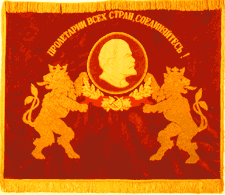 A strong case for the neutralization and domestication of ideological signs is found in the work of Afrika (Sergei Bugaev), a St. Petersburg artist. His Banners series from the early 1990s is of particular interest here. The red Soviet banners which Afrika collected along with other Soviet paraphernalia were forced to co-exist with symbols from incompatible cultural realms. American critics took to the postmodern irony of Africa’s playful juxtapositions, interpreting them as a variant of Sots Art and as ideological critique. But what about the banners themselves? Are they just a chance background, a ready-made substitute for a canvas? The banners as bearers of symbolic meanings are returned by Afrika to their status as fabric, textiles, material. Critics Victor Mazin and Olessya Turkina who have worked with Africa for many years, write about his banners:
A strong case for the neutralization and domestication of ideological signs is found in the work of Afrika (Sergei Bugaev), a St. Petersburg artist. His Banners series from the early 1990s is of particular interest here. The red Soviet banners which Afrika collected along with other Soviet paraphernalia were forced to co-exist with symbols from incompatible cultural realms. American critics took to the postmodern irony of Africa’s playful juxtapositions, interpreting them as a variant of Sots Art and as ideological critique. But what about the banners themselves? Are they just a chance background, a ready-made substitute for a canvas? The banners as bearers of symbolic meanings are returned by Afrika to their status as fabric, textiles, material. Critics Victor Mazin and Olessya Turkina who have worked with Africa for many years, write about his banners:
These priceless symbolic surrogates became the most sought-after collector’s items in the former USSR, and they were therefore invested with real value backed by the ideological “credit” of the once existing state. As soon as the banners lose their eternal, sacred character, they acquire the materiality of texture – plush or velvet, gold or silk embroidery, distinctive stitching, depth of hue. They turn from living symbols into objects of material culture.
 The texture of the banners (velvet or satin), their differences in hue, the quality of their embroidery, and the golden tassels all contribute to the figural subversion of the obvious grammatical articulation of its signs. One of Africa’s earliest textile collages, Golden Carpet, spells out this concern. The juxtaposition of an embroidered pastoral peasant scene with the stenciled faces of Soviet peasant women suggests not only a contrast of ideas, but also of materials and textures. It insists that ideas can only be experienced through materials, that ideology is em-bodied.
The texture of the banners (velvet or satin), their differences in hue, the quality of their embroidery, and the golden tassels all contribute to the figural subversion of the obvious grammatical articulation of its signs. One of Africa’s earliest textile collages, Golden Carpet, spells out this concern. The juxtaposition of an embroidered pastoral peasant scene with the stenciled faces of Soviet peasant women suggests not only a contrast of ideas, but also of materials and textures. It insists that ideas can only be experienced through materials, that ideology is em-bodied.
In art as in life, ideology is not erased by the material but its locus shifts from idea to materia. The collective memory that manifests itself in post-Soviet art and the rituals of the ex-Soviet émigré community are an assertion of the materiality of a life that, even if it was not materialist, was far from being immaterial. While Western critics read the work of post-Soviet artists primarily as reflecting on Soviet official symbolism, in the work of artists such as Peppers, the material containing political symbols moves from the background to the foreground. This collective memory of the material, in its paradoxical nostalgia, its “Sovietness”, validates the existence of those who were not merely subjects of ideological manipulation but lived as active agents capable of negotiating with the regime by domesticating and consuming its signs.
The overwhelming response to the 1996 exhibition of East German consumer culture at the Deutsches Historisches Museum in Berlin corroborates my argument. The nostalgically preserved and displayed objects of consumer culture from the other side of the Berlin Wall, including those special smells of bad communist laundry soaps, were primarily understood by the audience as validating the material life of the former subjects of the communist GDR, despite the victory of materialism.

